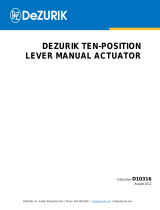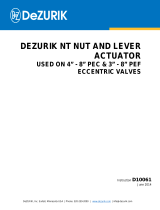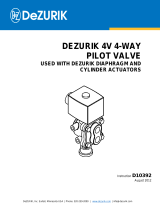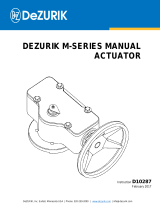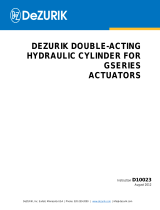Page is loading ...

DeZURIK, Inc. Sartell, Minnesota USA | Phone: 320-259-2000 | www.dezurik.com | [email protected]
DEZURIK DR-125
ROTARY DIAPHRAGM
ACTUATOR
Instruction D10507
September 2021

DeZURIK
Instruction and Operating Manual Page 2 © 2022 DeZURIK, Inc.
Instructions
These instructions are for use by personnel who are responsible for the installation, operation and
maintenance of DeZURIK valves, actuators or accessories.
Safety Messages
All safety messages in the instructions are identified by a general warning sign and the signal word CAUTION,
WARNING or DANGER. These messages indicate procedures to avoid injury or death.
Safety label(s) on the product indicate hazards that can cause injury or death. If a safety label becomes difficult
to see or read, or if a label has been removed, please contact DeZURIK for replacement label(s).
Personnel involved in the installation or maintenance of valves should be constantly alert to potential
emission of pipeline material and take appropriate safety precautions. Always wear suitable protection
when dealing with hazardous pipeline materials. Handle valves which have been removed from service
with suitable protection for any potential pipeline material in the valve.
Inspection
Your DeZURIK product has been packaged to provide protection during shipment; however, items can be
damaged in transport. Carefully inspect the unit for damage upon arrival and file a claim with the carrier if
damage is apparent.
Parts
Replaceable wear parts are listed on the assembly drawing. These parts can be stocked to minimize
downtime. Order parts from your local DeZURIK sales representative or directly from DeZURIK. When ordering
parts please provide the following information:
If the valve has a data plate: please include the 7-digit part number with either 4-digit revision number
(example: 9999999R000) or 8-digit serial number (example: S1900001) whichever is applicable. The
data plate will be attached to the valve assembly. Also, include the part name, the assembly drawing
number, the balloon number and the quantity stated on the assembly drawing.
If there isn't any data plate visible on the valve: please include valve model number, part name, and
item number from the assembly drawing. You may contact your local DeZURIK Representative to help
you identify your valve.
DeZURIK Service
DeZURIK service personnel are available to maintain and repair all DeZURIK products. DeZURIK also offers
customized training programs and consultation services. For more information, contact your local DeZURIK
sales representative or visit our website at DeZURIK.com.

DeZURIK
DR-125 Rotary Diaphragm Actuator
D10507 Page 3 September 2021
Table of Contents
Description ............................................................................................................................................. 4
Installation .............................................................................................................................................. 4
Operation ............................................................................................................................................... 4
Lubrication ............................................................................................................................................. 4
Parts Identification ................................................................................................................................. 5
Open and Closed Position Stops ........................................................................................................... 6
Removing Actuator from Valve ............................................................................................................... 8
Replacing Actuator on Valve .................................................................................................................. 8
Diaphragm Replacement ..................................................................................................................... 10
Reversing the Diaphragm Action .......................................................................................................... 13
Changing Actuator Mounting Position on Valve.................................................................................... 14
Actuator Disposal ................................................................................................................................. 14
Troubleshooting ................................................................................................................................... 15

DeZURIK
DR-125 Rotary Diaphragm Actuator
D10507 Page 4 September 2021
Description
The DR-125 Rotary Diaphragm Actuator is a pneumatic spring-return rotary actuator used for
on-off or modulating control of a quarter-turn valve. The model number 125 is the actuator size,
and designates the effective pressure area in square inches of the spring-loaded diaphragm.
The spring action may be spring-to-close or spring-to-open, and is reversible without additional
parts.
A choice of two spring ranges is available—35 or 60 psi (240 or 420 kPa).
Installation
One pneumatic signal line connection is required to the ½ NPT port on the end of the actuator.
The pneumatic signal pressure must equal, but not exceed by more than 10 psi (70 kPa), the
spring rating of 35 or 60 psi (240 or 420 kPa) as shown on the actuator label.
For high vibration installations, additional mounting support is recommended on the diaphragm
end of the actuator to prevent damage to the actuator and/or the piping system. Mount the
support from the pipeline to at least two of the diaphragm cover screws (B2) shown in Figure 1.
Tighten the screws to 18 ± 2 foot pounds (24 ± 3 Nm).
Operation
The actuator is powered pneumatically and rotates 90 degrees between the open and closed
positions. The action of the actuator is either spring-to-close or spring-to-open, as determined
by which side of the actuator is mounted to the valve, as shown in Figure 2. The action selected
is shown on the actuator label. With spring-to-close, increasing signal pressure to the actuator
opens the valve and decreasing pressure closes the valve; with spring-to-open, increasing
pressure closes the valve and decreasing pressure opens the valve.
Lubrication
The actuator is lubricated at the factory and does not require further lubrication.

DeZURIK
DR-125 Rotary Diaphragm Actuator
D10507 Page 5 September 2021
Parts Identification
Figure 1 - Parts Identification

DeZURIK
DR-125 Rotary Diaphragm Actuator
D10507 Page 6 September 2021
Open and Closed Position Stops
The open and closed position stops are the two hex head screws (B30) shown in Figure 1 and
on Figure 2. The stops are adjustable and prevent the actuator from rotating beyond the open
and closed positions of the valve. If the actuator is factory-mounted on the valve, the stops are
preset and do not require further adjustment.
If the actuator is not factory-mounted on the valve, or if the actuator is removed and/or
disassembled, the stops will require adjustment as described below. Refer to the valve
Instructions for closed-position information and adjust the stops with the actuator mounted on
the valve. Refer to Figure 1 for component identification.
For closed stop adjustment on spring-to-close actuators, or open stop adjustment on spring-to-
open actuators:
1. Relieve the air pressure to the actuator.
2. Loosen the jam nut (B31) on the appropriate stop screw (B30). Refer to Figure 1.
3. Turn the stop screw in or out until the valve is in the correct position. The screw will turn
easier if air pressure—just enough to relieve the force on the screw—is applied to the
actuator. Relieve the pressure to check the stop screw adjustment.
4. Hold the stop screw from turning, and tighten the jam nut to 230 ± 30 foot pounds (312 ±
41 Nm) if carbon steel, or to 140 ± 18 foot pounds (190 ± 24 Nm) if stainless steel.
For closed stop adjustment on spring-to-open actuators, or open stop adjustment on spring-to-
close actuators:
1. Apply—but do not exceed—the maximum air pressure to the actuator, as determined by
the spring rating shown on the actuator label.
2. Loosen the jam nut (B31) on the appropriate stop screw (B30). Refer to Figure 1 and
Figure 2.
3. Turn the stop screw in or out until the valve is in the correct position. The screw will turn
easier if the air pressure to the actuator is reduced. Reapply the maximum pressure in
step 1 above to check the stop screw adjustment.
4. Hold the stop screw from turning, and tighten the jam nut to 230 ± 30 foot pounds (312 ±
41 Nm) if carbon steel, or to 140 ± 18 foot pounds (190 ± 24 Nm) if stainless steel.
5. Relieve the air pressure to the actuator.

DeZURIK
DR-125 Rotary Diaphragm Actuator
D10507 Page 7 September 2021
Open and Closed Position Stops (continued)
Figure 2 - Open and Closed Position Stops

DeZURIK
DR-125 Rotary Diaphragm Actuator
D10507 Page 8 September 2021
Removing Actuator from Valve
Refer to Figure 1 for component identification.
1. Shut down the flow in the pipeline.
Flow in the pipeline with the actuator removed can slam the valve closed causing
personal injury and damaging the flow system. Shut down the flow in the pipeline
before removing the actuator from the valve.
2. Disconnect and lock out the pneumatic power to the actuator to prevent accidental
operation of the actuator. Ensure that the actuator and pipeline are de-energized.
Moving parts from unexpected operation of a powered actuator can cause
personal injury. Disconnect and lock out power to the actuator before servicing.
3. Remove the pointer screw (B23), pointer (B26), and washer (B19) from the actuator.
4. Apply about 10 psi (70 kPa) air pressure to the actuator, and remove the four top cover
screws (B37) and the top cover (B27).
Removal or replacement of the top cover without pressure on the actuator is very
difficult and could cause damage to the actuator or valve.
5. Remove the shoulder screw (B21) from the link arm (B6).
6. Relieve the air pressure to the actuator from step 4.
7. Loosen the two link arm screws (B8) and nuts (B9) and remove the link arm (B6) from
the valve shaft.
8. Remove the four actuator mounting screws (B35) and lockwashers (B36) and remove
the actuator.
Replacing Actuator on Valve
Refer to Figure 1 for component identification.
1. If the actuator lower cover (B32) has been removed from the valve adaptor, replace it
and tighten the valve adaptor fasteners as shown in Table A.
2. Place the valve in the closed position for a spring-to-close actuator or in the open
position for a spring-to-open actuator.
3. Select the desired mounting orientation for mounting the actuator on the valve. Refer to
limitations in the “Changing Actuator Mounting Position on Valve” section of this
instruction.
4. Fasten the actuator to the bottom cover (B32) with the four 1/2”-13 mounting screws
(B35) and lockwashers (B36). Tighten the screws as shown in Table A.
5. Align the shaft hole in the link arm (B6) with the valve shaft and slide the link arm onto
the shaft.

DeZURIK
DR-125 Rotary Diaphragm Actuator
D10507 Page 9 September 2021
Replacing Actuator on Valve (continued)
Table A: Torque Requirements for Actuator Mounting Screws
Screw Size
Carbon Steel
Stainless Steel
Foot Pounds
Newton Meters
Foot Pounds
Newton Meters
1/2”-13
108 ± 14
146 ± 19
49 ± 7
66 ± 9
M8 X 1.25
23 ± 3
31 ± 4
16 ± 2
22 ± 3
M12 X 1.75
83 ± 10
113 ± 14
58 ± 8
79 ± 11
M20 X 2.5
435 ± 60
590 ± 81
300 ± 40
400 ± 54
6. Position the link arm (B6) 1-1/32" (26.2 mm) below the top of the actuator as shown in
Detail “A” of Figure 1.
7. Tighten the two link arm screws (B8) and nuts (B9) to 108 ± 14 foot pounds (146 ± 19
Nm).
8. Apply air pressure so that the rod end (B20) is aligned between the holes in the link arm
(B6). Apply Loctite 243 to the threads of screw (B21), and connect the rod end to the link
arm. Tighten the screw to 151 ± 20 foot pounds (205 ± 27 Nm).
9. Position the O-ring (B24) in the groove in the stub shaft (B29) and mount the gasket
(B28) and cover (B27) to the actuator with the four screws (B37). Tighten the screws to
108 ± 14 foot pounds (146 ± 19 Nm) if carbon steel, or to 49 ± 7 foot pounds (66 ± 9 Nm)
if stainless steel.
10. Relieve the air pressure to the actuator. Mount the pointer (B26) to the stub shaft (B29)
with the screw (B23) and washer (B19) under the pointer. Tighten the screw to 55 ± 8
foot pounds (75 ± 11 Nm) if carbon steel, or to 33 ± 4 foot pounds (45 ± 5 Nm) if
stainless steel.
11. Re-mount any accessories that were removed and connect all pneumatic and electrical
connections.
12. Operate the valve to check the open and closed positions. Adjust the stops, if necessary,
as described in the “Open and Closed Position Stops” section.

DeZURIK
DR-125 Rotary Diaphragm Actuator
D10507 Page 10 September 2021
Diaphragm Replacement
Refer to Figure 1 for parts identification.
This actuator includes a compressed spring. Death or serious injury can result if the
spring cover is removed improperly.
1. Shut down the flow in the pipeline.
Flow in the pipeline with the actuator removed can slam the valve closed causing
personal injury and damaging the flow system. Shut down the flow in the pipeline
before removing the actuator from the valve.
2. Disconnect and lock out the pneumatic power to the actuator to prevent accidental
operation of the actuator.
Moving parts from unexpected operation of a powered actuator can cause
personal injury. Disconnect and lock out power to the actuator before servicing.
3. Remove the pointer screw (B23), pointer (B26), and washer (B19) from the actuator.
4. Apply about 10 psi (70 kPa) air pressure to the actuator, and remove the four top cover
screws (B37) and the top cover (B27).
Removal or replacement of the top cover without pressure on the actuator is very
difficult and could cause damage to the actuator or valve.
5. Remove the shoulder screw (B21) from the link arm (B6).
6. Relieve the air pressure to the actuator from step 4.
7. Remove three screws (B2), nuts (B3), and washers (B38) from the diaphragm cover
(B1). The three screws removed must be equally spaced as shown in Figure 3.

DeZURIK
DR-125 Rotary Diaphragm Actuator
D10507 Page 11 September 2021
Diaphragm Replacement (continued)
Figure 3 - Stud Requirements for Diaphragm Cover Removal
8. Obtain three 3/8" diameter threaded rods, each at least 14" (355 mm) long, and nine 3/8"
nuts. As shown in Figure 3, assemble one rod and three nuts in each of the holes from
which the screws were removed in the previous step. Jam the double nuts together by
tightening to 26 ± 3 foot pounds (35 ± 4 Nm); tighten the single nuts finger tight against
the cover.
9. Remove the remaining screws (B2), nuts (B3), and washers (B38) from the diaphragm
cover (B1).
10. Turn the single nuts counterclockwise—carefully, evenly, and slowly— from each of the
three threaded rods. Continue turning each nut until the spring force is fully relieved from
the diaphragm cover (B1). Then, remove the nuts, the threaded rods, and the diaphragm
cover from the actuator.
11. Remove the rubber diaphragm (B13) from the housing (B5).
DO NOT DISASSEMBLE THE SPRING ASSEMBLY
The spring assembly includes a compressed spring. Death or serious injury can
result if the spring is disassembled.

DeZURIK
DR-125 Rotary Diaphragm Actuator
D10507 Page 12 September 2021
Diaphragm Replacement (continued)
12. Mount the new diaphragm (B13) and the diaphragm cover (B1) to the housing (B5) with
screws (B2), washers (B38) and nuts (B3). Place the caution tag (B4) under one of the
screws. Tighten the screws evenly until the rubber diaphragm is in contact with the cover
and the housing. Then, tighten the screws in a crisscross pattern to 18 ± 2 foot pounds
(24 ± 3 Nm).
13. Apply air pressure so that the rod end (B20) is aligned between the holes in the link arm
(B6). Apply Loctite 242 to the threads of screw (B21), and connect the rod end to the link
arm. Tighten the screw to 151 ± 20 foot pounds (205 ± 27 Nm).
14. Position the O-ring (B24) in the groove in the stub shaft (B29), and mount the gasket
(B28) and cover (B27) to the actuator with the four screws (B37). Tighten the screws to
108 ± 14 foot pounds (146 ± 19 Nm) if carbon steel, or to 49 ± 7 foot pounds (66 ± 9 Nm)
if stainless steel.
15. Relieve the air pressure to the actuator. Mount the pointer (B26) to the stub shaft (B29)
with the screw (B23) and washer (B19) under the pointer. Tighten the screw to 55 ± 8
foot pounds (75 ± 11 Nm) if carbon steel, or to 33 ± 4 foot pounds (45 ± 5 Nm) if
stainless steel.
16. Re-connect all pneumatic and electrical connections.
17. Operate the valve to check the open and closed positions. Adjust the stops, if necessary,
as described in the Open and Closed Position Stops section.

DeZURIK
DR-125 Rotary Diaphragm Actuator
D10507 Page 13 September 2021
Reversing the Diaphragm Action
Refer to Figure 1 for parts identification.
1. Shut down the flow in the pipeline.
Flow in the pipeline with the actuator removed can slam the valve closed causing
personal injury and damaging the flow system. Shut down the flow in the pipeline
before removing the actuator from the valve.
2. Disconnect and lock out the pneumatic power to the actuator to prevent accidental
operation of the actuator.
Moving parts from unexpected operation of a powered actuator can cause
personal injury or equipment damage. Disconnect and lock out power to the
actuator before servicing.
3. Remove the pointer screw (B23), pointer (B26), and washer (B19) from the actuator.
4. Apply about 10 psi (70 kPa) air pressure to the actuator, and remove the four top cover
screws (B37) and the top cover (B27). Removal or replacement of the top cover without
pressure on the actuator is very difficult and could cause damage to the actuator or
valve.
5. Remove the shoulder screw (B21) from the link arm (B6).
6. Relieve the air pressure to the actuator and disconnect the actuator piping.
7. Remove the four actuator mounting screws (B35) and washers (B36), and remove the
actuator.
8. Loosen the two link arm screws (B8) and remove the stub shaft (B29) from the link arm
(B6); remove the link arm from the valve shaft, and replace the link arm on the valve
shaft in the appropriate position as shown in Figure 2.
9. Turn the actuator over, verify position and re-mount the actuator to the bottom cover with
the same screws (B35) and washers (B36). Tighten the screws as shown in Table A.
10. Position the link arm 1-1/32" (26.2 mm) below the top of the actuator as shown in Detail
“A” of Figure 1.
11. Tighten the two link arm screws (B8) to 108 ± 14 foot pounds (146 ± 19 Nm).
12. Connect the actuator piping. Apply air pressure so that the rod end (B20) is aligned
between the holes in the link arm (B6). Apply Loctite 242 to the threads of screw (B21)
and connect the rod end to the link arm. Tighten the screw to 151 ± 20 foot pounds (205
± 27 Nm).
13. Position the O-ring (B24) in the groove in the stub shaft (B29) and mount the gasket
(B28) and cover (B27) to the actuator with the four screws (B37). Tighten the screws to
108 ± 14 foot pounds (146 ± 19 Nm) if carbon steel, or to 49 ± 7 foot pounds (66 ± 9 Nm)
if stainless steel.

DeZURIK
DR-125 Rotary Diaphragm Actuator
D10507 Page 14 September 2021
Reversing the Diaphragm Action (continued)
14. Relieve the air pressure to the actuator. Mount the pointer (B26) to the stub shaft (B29)
with the screw (B23) and washer (B19) under the pointer. Tighten the screw to 55 ± 8
foot pounds (75 ± 11 Nm) if carbon steel, or to 33 ± 4 foot pounds (45 ± 5 Nm) if
stainless steel.
15. Re-mount any accessories that were removed and connect all pneumatic and electrical
connections.
16. Operate the valve to check the open and closed positions. Adjust the stops, if necessary,
as described in the Open and Closed Position Stops section.
Changing Actuator Mounting Position on Valve
Before changing the actuator mounting position, check to assure that pipeline flange clearance
and room clearance is available for the proposed actuator location.
The actuator may be mounted on the valve in any of four mounting positions — standard, 90°,
180°, or 270°— as shown on the Installation Drawing. All four mounting positions may not be
available on all valve sizes. Check installation drawings to verify valid mounting positions. To
change the mounting position, follow the steps in the Removing Actuator from Valve section and
the Replacing Actuator on Valve section
Actuator Disposal
Remove the actuator from the valve by following the instructions described in the Removing
Actuator from Valve section.
Before disposing of the actuator or spring assembly, the compressed spring pressure must be
relieved. For this to be completed safely, the spring assembly must be contained within the
spring housing. Use a cutting torch to cut through the housing in at least 2 locations. Next, use
the torch to cut through the spring coils in those locations. Ensure that all sections of the spring
are loose within the housing before disposal.
Figure 4 - Disposal Cutting

DeZURIK
DR-125 Rotary Diaphragm Actuator
D10507 Page 15 September 2021
Troubleshooting
Condition
Possible Cause
Corrective Action
Actuator will not
operate valve.
Rubber diaphragm is
ruptured.
Replace diaphragm.
See Diaphragm Replacement section.
Place in unlocked condition..
Actuator closes to
wrong position.
Closed position stop is
set incorrectly.
Adjust closed position stop.
See Open and Closed Position Stops
section.
Actuator opens to
wrong position.
Open position stop is set
incorrectly.
Adjust open position stop.
See Open and Closed Position Stops
section.
Actuator will not fully
operate valve.
Actuator air pressure is
low.
Increase air pressure. Do not exceed spring
rating.
Actuator is sized
incorrectly.
Use spring with increased rating, or use
larger actuator.
Pipeline obstruction in
valve is preventing
closure.
Remove obstruction.
Spring operates
valve in wrong
direction.
Spring-to-close should
be spring-to-open or vice
versa.
Reverse the action.
See Reversing Actuator Action section.

Limited Warranty
DeZURIK, Inc. (“Seller”) manufactured products, auxiliaries and parts thereof that we manufacture for a period of twenty-four (24) months from date
of shipment from Seller’s factory, are warranted to the original purchaser only against defective workmanship and material, but only if properly stored,
installed, operated, and serviced in accordance with Seller’s recommendations and instructions.
For items proven to be defective within the warranty period, your exclusive remedy under this limited warranty is repair or replacement of the defective
item, at Seller’s option, FCA Incoterms 2020 Seller’s facility with removal, transportation, and installation at your cost.
Products or parts manufactured by others but furnished by Seller are not covered by this limited warranty. Seller may provide repair or replacement
for other’s products or parts only to the extent provided in and honored by the original manufacturer’s warranty to Seller, in each case subject to the
limitations contained in the original manufacturer’s warranty.
No claim for transportation, labor, or special or consequential damages or any other loss, cost or damage is being provided in this limited warranty.
You shall be solely responsible for determining suitability for use and in no event shall Seller be liable in this respect.
This limited warranty does not warrant that any Seller product or part is resistant to corrosion, erosion, abrasion or other sources of failure, nor does
Seller warrant a minimum length of service.
Your failure to give written notice to us of any alleged defect under this warranty within twenty (20) days of its discovery, or attempts by someone other
than Seller or its authorized representatives to remedy the alleged defects therein, or failure to return product or parts for repair or replacement as
herein provided, or failure to store, install, or operate said products and parts according to the recommendations and instructions furnished by Seller
shall be a waiver by you of all rights under this limited warranty.
This limited warranty is voided by any misuse, modification, abuse or alteration of Seller’s product or part, accident, fire, flood or other Act of God, or
your failure to pay entire contract price when due.
The foregoing limited warranty shall be null and void if, after shipment from our factory, the item is modified in any way or a component of another
manufacturer, such as but not limited to; an actuator is attached to the item by anyone other than a Seller factory authorized service personnel.
All orders accepted shall be deemed accepted subject to this limited warranty, which shall be exclusive of any other or previous warranty, and this
shall be the only effective guarantee or warranty binding on Seller, despite anything to the contrary contained in the purchase order or represented by
any agent or employee of Seller in writing or otherwise, notwithstanding, including but not limited to implied warranties.
THE FOREGOING REPAIR AND REPLACEMENT LIMITED WARRANTY IS IN LIEU OF ALL OTHER WARRANTIES, OBLIGATIONS AND
LIABILITIES, INCLUDING, BUT NOT LIMITED TO, ALL WARRANTIES OF FITNESS FOR A PARTICULAR PURPOSE OR OF MERCHANTABILITY
OR OTHERWISE, EXPRESSED OR IMPLIED IN FACT OR BY LAW, AND STATE SELLER’S ENTIRE AND EXCLUSIVE LIABILITY AND YOUR
EXCLUSIVE REMEDY FOR ANY CLAIM IN CONNECTION WITH THE SALE AND FURNISHING OF SERVICES, GOODS OR PARTS, THEIR
DESIGN, SUITABILITY FOR USE, INSTALLATION OR OPERATIONS. NEITHER ANY PERFORMANCE OR OTHER CONDUCT, NOR ANY ORAL
OR WRITTEN INFORMATION, STATEMENT, OR ADVICE PREPARED BY SELLER OR ANY OF OUR EMPLOYEES OR AGENTS WILL CREATE A
WARRANTY, OR IN ANY WAY INCREASE THE SCOPE OR DURATION OF THE LIMITED WARRANTY.
Disclaimer
Metric fasteners should not be used with ASME Class 150/300 bolt holes and flange bolt patterns. If you use metric fasteners with ASME Class 150/300
bolt holes and flange bolt patterns, it may lead to product failure, injury, and loss of life. DeZURIK Inc. disclaims all liability associated with the use of
metric fasteners with ASME Class 150/300 bolt holes and flange patterns, including but not limited to personal injury, loss of life, loss of product,
production time, equipment, property damage, lost profits, consequential damages of any kind and environment damage and/or cleanup. Use of metric
fasteners with ASME Class 150/300 bolt holes and flange bolt patterns is a misuse that voids all warranties and contractual assurances. If you use
metric fasteners with ASME Class 150/300 bolt holes and flange bolt patterns, you do so at your sole risk and any liability associated with such use shall
not be the responsibility of DeZURIK, Inc. In addition to the foregoing, DeZURIK’s Manufacturer’s Conditions apply.
Limitation of Liability
IN NO EVENT SHALL SELLER BE LIABLE FOR ANY DIRECT, INDIRECT, SPECIAL, PUNITIVE, EXEMPLARY, OR CONSEQUENTIAL DAMAGES
(INCLUDING, BUT NOT LIMITED TO; DAMAGE TO OR LOSS OF OTHER PROPERTY OR EQUIPMENT, BUSINESS INTERUPTION, COST OF
SUBSTITUTE PRODUCTS, LOSS OF TIME, LOSS OF PROFITS OR REVENUE, COST OF CAPTIAL, LOSS OF USE, OR DIMINUTION IN VALUE)
WHATSOEVER, AND SELLER’S LIABILITY, UNDER NO CIRCUMSTANCES, WILL EXCEED THE CONTRACT PRICE FOR THE GOODS AND/OR
SERVICES FOR WHICH LIABILITY IS CLAIMED. ANY ACTION FOR BREACH OF CONTRACT BY YOU, OTHER THAN RIGHTS RESPECTING OUR
LIMITED WARRANTY DESCRIBED ABOVE, MUST BE COMMENCED WITHIN 12 MONTHS AFTER THE DATE OF SALE.
Sales and Service
For information about our worldwide locations, approvals, certifications and local representative:
Web site: www.dezurik.com E-Mail: info@dezurik.com
250 Riverside Ave. N., Sartell, MN 56377 ● Phone: 320-259-2000 ● Fax: 320-259-2227
DeZURIK, Inc. reserves the right to incorporate our latest design and material changes without notice or obligation.
Design features, materials of construction and dimensional data, as described in this manual, are provided for your information only
and should not be relied upon unless confirmed in writing by DeZURIK, Inc. Certified drawings are available upon request.
December 2022
/

